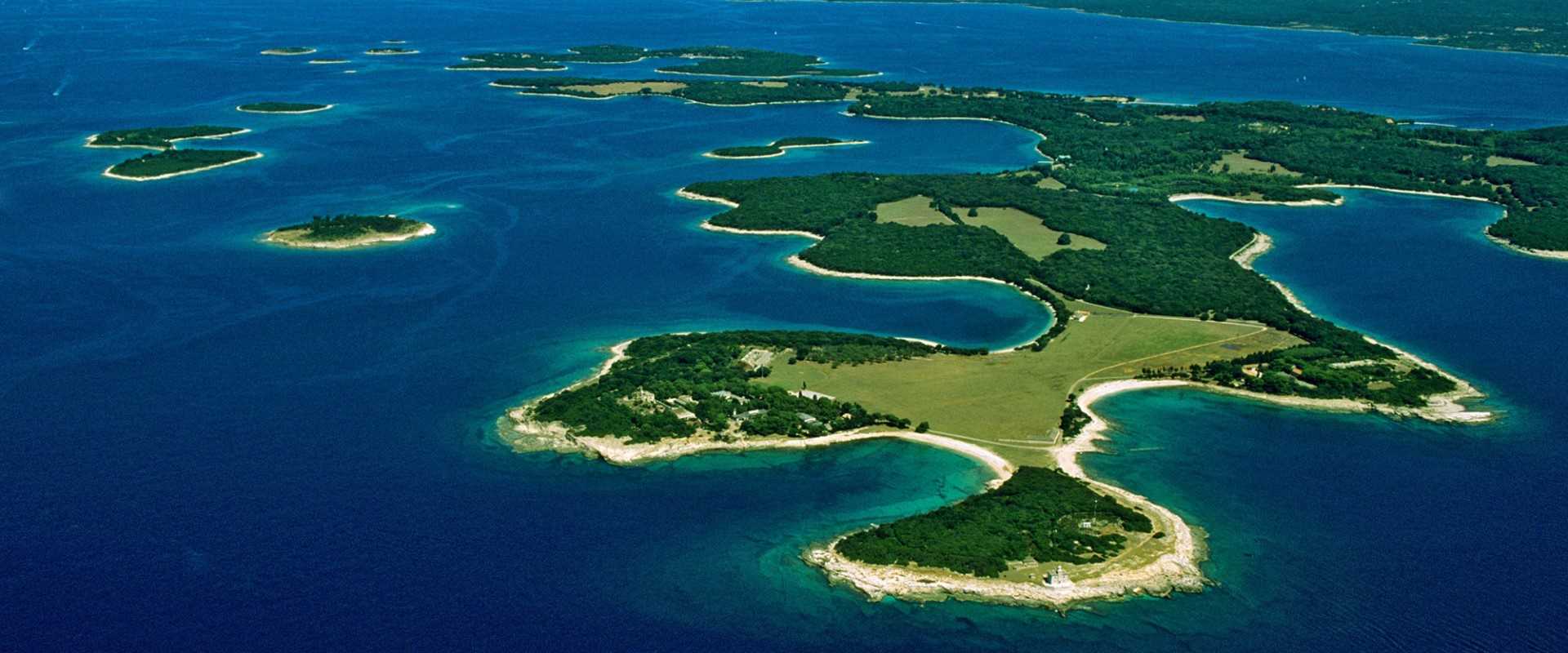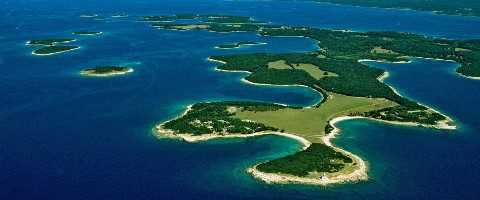The Brijuni islands are a chain of 14 small islands and islets located off the south west coast of the Istrian peninsula and situated across the Fazana channel from the pretty seaside town of Fazana.
The city of Pula is just 9,5 kilometres away, some 15 minutes’ drive. A regular boat service connects Fazana with the harbour on Veli Brijun in just 15 minutes and runs all year.
None of the islands are inhabited other than by guests who stay on the island of Veli Brijun in summer. Very rarely, senior officials of the Croatian Government use one of the private villas.
The Brijuni Islands became a National Park in 1983 and this was when visitors were first allowed onto the islands.
Today, most of the islands remain off limits to visitors other than Veli Brijun where visitors can stay in two hotels and a couple of luxury villas and to Mali Brijun for an event as this island is an additional venue for concerts during the famous Ulysses festival in August (the concert ticket includes the return boat trip from Fazana).
Veli/Veliki Brijun is the largest of the islands and contains most of the treasures. It is both beautiful and surreal and one journalist wrote that it is where “English country estate meets Jurassic Park” (that’s because of the dinosaurs, please read on).
What visitors will experience are hectares of well-maintained, green parkland surrounded by the dazzling blue Adriatic and planted with avenues of ancient pine trees.
There is a golf course (with natural fairways-no fertilisers are used, just the roaming deer do their best) with sand greens. Elsewhere on the island there are botanical gardens, several museums and exhibitions, the main archaeological sites, the two hotels and a couple of restaurants, terrace café-bars, a couple of luxury villas for rental, a shop selling Brijuni memorabilia plus Saluga beach restaurant and beach bar. At the harbour, there is a clear map of the islands including details of where to find the dinosaur footprints that dot the island’s shoreline.
Day trip visitors either take the “toy” tourist train with a guide around the island and then explore alone in free time or hire bicycles or golf buggies to get around on their own. Walking is possible too.
Guests who choose to stay on the island overnight or for a longer holiday can use all options to explore.
Brijuni went down in history as Tito’s summer residence between 1949 and 1979. In fact, the charismatic and controversial president of ex-Yugoslavia often spent more than just the summer here and was often based there for well over six months a year between his other homes and his world travels.
It was here that he entertained world leaders and monarchs as well as glamorous celebrity friends including Richard Burton and Elizabeth Taylor and Sophia Loren. Tito loved animals and many who visited him brought animals as presents and thus his “safari park” came about. The former Prime Minister of India, the late Indira Gandhi presented him with two elephants which were named Sony and Lanka. Sony died in 2012 and Lanka is still there. The Shetland ponies who live on the island are the direct descendants of ponies given as gifts by the late Her Majesty Queen Elizabeth II of Great Britain who visited in 1972 with her husband Prince Philip and their daughter Princess Anne. The list of world leaders is long and includes JFK, Haile Selassie, Fidel Castro and many more.
This is the short summary of the recent history of the Brijuni islands and it is worth going back further in history because it is quite fascinating – and extraordinary.
The oldest remains of human habitation date from 3,000 BC in the bay of Javorika and is just one small part of ancient settlements. There are over 100 acres of archaeological sites on the islands. On Veli Brijun, after 177 BC, the Romans built villas and structures for processing olive oil and the making of amphorae. The last of their olive trees dates from AD 400, is still thriving and still produces several litres of oil each year – visitors can read the sign by the tree.
Not to be missed on Veli Brijun is the largest Roman complex here – at Verige Bay. There was once an impressive series of temples, palaces, thermal baths and a fish pond. There was also a working harbour with buildings that remained in use until the 6th century. Some columns remain from the temples and the spot can be booked for weddings and special events (organised through the National Park office). As sea levels have changed, the waters of Verige Bay are very shallow and swimmers may find that they are touching a piece of Roman tile on the sea bed. There are underwater trails following the site with interpretation boards.
Moving forward, in 1312 an outbreak of bubonic plague wiped out the population so that when the Venetians invaded in 1331 to claim the islands, there was nobody there. During this period the area became very marshy and a haven for mosquitoes who had the place to themselves.
Nothing changed until 1893 when Austrian steel magnate Paul Kupelweiser bought the island to add to his real estate portfolio and he had a dream to create an English-style country park. He was aware of the work of renowned German microbiologist and physician Robert Koch who, in 1900, was about to begin experiments in Tuscany regarding the eradication of malaria. Kupelweiser managed to persuade Koch to carry out his preliminary research on Brijuni rather than Tuscany and this proved to be a stroke of genius. It was a total success and the islands became mosquito and malaria free. Koch went on to succeed with other diseases including cholera and tuberculosis and a carved monument of him stands in his honour by the harbour in Veli Brijun; there is also a Robert Koch marked promenade.
Kupelweiser then went full speed ahead to excavate the archaeological treasures and also to realise his dream. He planted trees, he landscaped exotic gardens, he brought fresh water and electricity to the island, built stunning villas, a heated seawater swimming pool and Europe’s first 18-hole golf course. Vienna’s nobility and high society flocked here for their summer enjoyment. Kupelweiser’s dream had been realised but he sadly died in 1918.
Later, the islands passed into the hands of Mussolini’s Italy and during this time a casino, polo club and tennis courts were built – only the tennis courts remain and have been regularly improved.
And then came Tito. After World War 2, the Brijuni archipelago, along with the rest of the Istria region became part of Tito’s Yugoslavia. Brijuni became his base where he conducted high level diplomacy with world leaders. The Non-Aligned Movement ** (see below) was created here with a pact signed in 1956.
When visitors walk along the waterfront at Fazana on the mainland and board the boat to Veli Brijun, they are following in the footsteps of leaders, politicians, and the rich and famous from the 1960’s. In the main museum just along from the harbour, the exhibition “Josip Broz Tito on Brijuni” tells the whole story with hundreds of amazing photographs.
Years earlier, Kupelweiser had created a small personal zoo for his own pleasure. The animals presented to Tito on Veli Brijun used that same space and at one time there were elephants, deer, horses and ponies, bears, tigers and zebra. Those which died were stuffed and placed in Brijuni’s Natural History Museum, also near the harbour. The zebras wandering in the “safari park” today are also the descendants (like the shetlands) of the original residents.
Writers have described Veli Brijun in many ways. One wrote “Roman villas, Roman ruins, Yugoslav mansions and wild deer, all of them on Brijuni” Another wrote “it’s vintage chic for those Belle Epoque pleasure seekers”.
At Sunvil, we are delighted that the Brijuni islands are protected and monitored for ecological, environmental and nature conservation. A number of international resort chains have expressed interest in turning these islands into a kind of massive Las Vegas-type resort with casinos and the rest of it. Ask any Croat about this and they will look you very directly in the eyes and usually just reply with one word. “Never”.
The website of the Brijuni National Park describes these islands as “untouched nature of beautiful islands”. Sunvil’s Croatia expert’s comment to that was simply “beautiful is an understatement”.
A holiday staying at either Hotel Istra, Hotel Neptun or at the luxury Villa Lovorka or Villa Dubravka on Veli Brijun may well have you talking about this Croatian holiday for a very long time. In so many ways.
** The Non-Aligned Movement
This was founded during the Cold War by Josip Broz Tito of Yugoslavia, Gamal Abder Nasser of Egypt and Jawaharlal Nehru of India. The NAM was an association of countries that declined to take the side of either of the two world superpowers of that time, the capitalist USA and the Communist USSR. Many of the countries that joined the alliance were former colonies that had recently freed themselves from foreign domination and were against forming new ties with any big power. Key issues were politics, defence and economics. Despite the members being from vastly differing political views (and cultures), the movement formed an important buffer between the Communist East and the capitalist West. Today there are 120 member countries. And it all started on the Brijuni islands in modern day Croatia.
Did you know?
- As of summer 2022, Tito’s pet cockatoo named Koki was still alive and was regularly cackling obscenities to passers-by (fortunately in Croatian).
- The small drinks-ice cream booth near the elephant residence booms out classical music. The barman who has worked there for many years (and who is constantly smiling) organises this and says that “the animals love classical music”. There is a seating area and toilets here.
- More than 200 footprints of dinosaurs have been discovered on the Brijuni islands and it is believed that the reptiles walked here 130-100 million years ago. This is well marked on Veli Brijun for visitors and entrance is through a high gate near the safari park. The footprints are by the water’s edge and a board provides detailed paleontological information.
- The three private villas owned by Tito including his famous Bijela Kuca (White House) can occasionally be glimpsed when swimming at one of the island beaches.
- There are many swimming spots and where not allowed, this is clearly shown by a prohibited sign
- Park rangers are discreet and friendly but anyone found damaging the natural environment, lighting fires, throwing rubbish etc may receive an on-the-spot fine and/or be asked to undo the damage. There are signs in English everywhere about protecting the environment.





